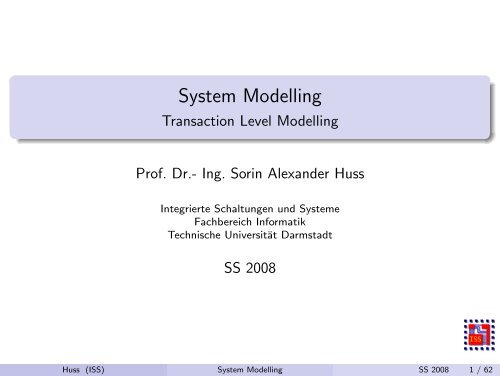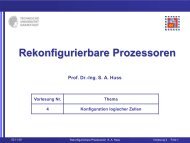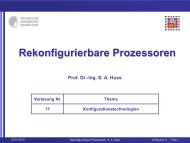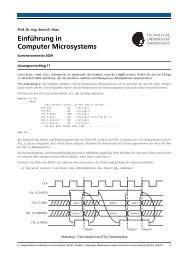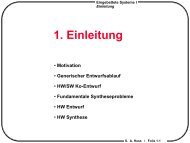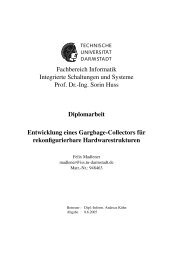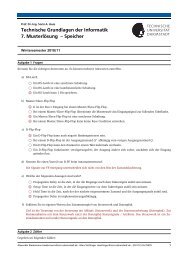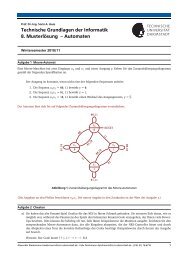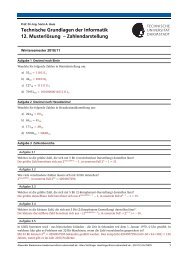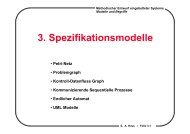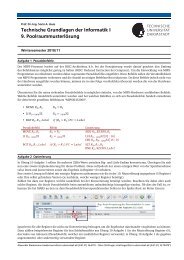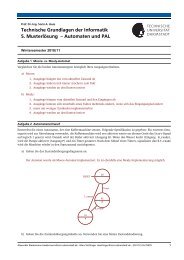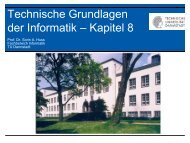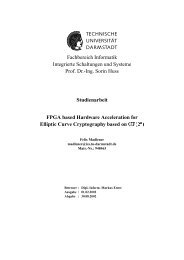System Modelling - Technische Universität Darmstadt
System Modelling - Technische Universität Darmstadt
System Modelling - Technische Universität Darmstadt
Create successful ePaper yourself
Turn your PDF publications into a flip-book with our unique Google optimized e-Paper software.
<strong>System</strong> <strong>Modelling</strong><br />
Transaction Level <strong>Modelling</strong><br />
Prof. Dr.- Ing. Sorin Alexander Huss<br />
Integrierte Schaltungen und <strong>System</strong>e<br />
Fachbereich Informatik<br />
<strong>Technische</strong> Universität <strong>Darmstadt</strong><br />
SS 2008<br />
Huss (ISS) <strong>System</strong> <strong>Modelling</strong> SS 2008 1 / 62
Transaction-Level Models with <strong>System</strong>C<br />
TLM Methodology<br />
Introduction to <strong>System</strong>C<br />
Transaction Level <strong>Modelling</strong> in <strong>System</strong>C<br />
(Source: Frank (Ed.) Ghenassia, editor. Transaction-Level Modeling with <strong>System</strong>C.<br />
Springer, June 2005)<br />
Huss (ISS) <strong>System</strong> <strong>Modelling</strong> SS 2008 2 / 62
TLM provides a methodology for<br />
Early software development<br />
Architecture analysis<br />
Functional verification<br />
Huss (ISS) <strong>System</strong> <strong>Modelling</strong> SS 2008 3 / 62
Novel design flow for embedded systems<br />
Customer Specification<br />
Paper Specification<br />
HW/SW Partitioning<br />
TLM<br />
Hardware<br />
Development<br />
Concurrent<br />
HW/SW<br />
Engineering<br />
Based on TLM<br />
Software<br />
Development<br />
Test Chip<br />
<strong>System</strong> Integration<br />
& Validation<br />
Chip Fabrication<br />
Huss (ISS) <strong>System</strong> <strong>Modelling</strong> SS 2008 4 / 62
Triple abstraction stucture<br />
1 Functional view<br />
2 Architecture view<br />
3 Micro-architecture view<br />
Huss (ISS) <strong>System</strong> <strong>Modelling</strong> SS 2008 5 / 62
1. Functional view<br />
abstracts the expected behavior of a given system<br />
executable specification of ths system function composed of<br />
algorithmic SW<br />
no consideration of any implementation details - such as architecture<br />
or address mapping information - and of perfomance figures<br />
Huss (ISS) <strong>System</strong> <strong>Modelling</strong> SS 2008 6 / 62
2. Architecture view<br />
provides the platform for associated SW development<br />
provides the reference model for verification purposes, i.e., for the<br />
generation of functional verfication tests of subsequent<br />
implementation models<br />
Huss (ISS) <strong>System</strong> <strong>Modelling</strong> SS 2008 7 / 62
3. Micro-architecture view<br />
captures all required information for timed and cycle-accurate<br />
simulation of RT level models<br />
validates low-level embedded SW in the real HW simulation<br />
environment<br />
validation of micro-architecture for real-time requirements<br />
Huss (ISS) <strong>System</strong> <strong>Modelling</strong> SS 2008 8 / 62
Principles of TLM<br />
<strong>Modelling</strong> of components as modules<br />
Communication structure by means of channels<br />
Modules and channels are bound to each other by communication<br />
ports<br />
A set of data is exchanged by a transaction<br />
<strong>System</strong> synchronisation is an explicit action between modules, e. g.,<br />
interrupt by DMA to notify a transfer completion<br />
Huss (ISS) <strong>System</strong> <strong>Modelling</strong> SS 2008 9 / 62
<strong>Modelling</strong> approach<br />
TLM modules must hold the following characteristics:<br />
Bit-true behavior of the component<br />
Register-accurate interface of the component<br />
<strong>System</strong> synchronisation managed by the component<br />
Huss (ISS) <strong>System</strong> <strong>Modelling</strong> SS 2008 10 / 62
TLM vs. RT level simulation<br />
S1<br />
S1<br />
F TLM<br />
TLM Simulation RTL SimulationF RTL<br />
S2<br />
S2<br />
Huss (ISS) <strong>System</strong> <strong>Modelling</strong> SS 2008 11 / 62
<strong>Modelling</strong> accuracy<br />
Granularity of communication data<br />
Levels: application packet, bus packet, bus size<br />
(Example video transfer: frame, line, pixel)<br />
Timing accuracy<br />
Levels: untimed, approximately-timed, timed TLM<br />
Huss (ISS) <strong>System</strong> <strong>Modelling</strong> SS 2008 12 / 62
<strong>Modelling</strong> accuracy (2)<br />
Data Granularity<br />
RTL<br />
Bus Size<br />
Bus Packet<br />
Application<br />
Packet<br />
TLM−PV<br />
Algorithmic Model<br />
TLM−PVT<br />
BCA<br />
TLM−PVT<br />
TLM−PV<br />
CA<br />
Legend:<br />
RTL register transfer level<br />
BCA bus cycle accurate<br />
CA cycle accurate<br />
PV programmer’s view<br />
PVT programmer’s view<br />
plus timing<br />
Untimed<br />
Approximately−timed<br />
Cycle−accurate<br />
Timed Accuracy<br />
Huss (ISS) <strong>System</strong> <strong>Modelling</strong> SS 2008 13 / 62
Untimed TLM - Model of Computation<br />
Characteristics<br />
Concurrent execution of independent processes<br />
Respect for causal process dependencies by using system<br />
synchronisation<br />
Bit-true behavior<br />
Bit-true communication<br />
Huss (ISS) <strong>System</strong> <strong>Modelling</strong> SS 2008 14 / 62
Untimed TLM - <strong>System</strong> Synchronisation<br />
Execution order within P1, P2, P3: <strong>System</strong> syncronisation between<br />
concurrent processes:<br />
P1<br />
P2<br />
P3<br />
Simulation Timeline<br />
P11<br />
P12<br />
Synchronization 1<br />
Synchronization 2<br />
P21<br />
P22<br />
P31<br />
P32<br />
1 P11 → P12 for P1<br />
2 P21 → P22 for P2<br />
3 P31 → P32 for P3<br />
4 P11 → P22<br />
5 P22 → P12<br />
Huss (ISS) <strong>System</strong> <strong>Modelling</strong> SS 2008 15 / 62
Untimed TLM - <strong>System</strong> Synchronisation (2)<br />
Different overall execution order (process interleaves) examples:<br />
1 P21 → P11 → P22 → P12 → P31 → P32<br />
2 P31 → P32 → P21 → P11 → P22 → P12<br />
Syncronisation kinds:<br />
Emit-synchronisation A process sends out a synchr. that may influence the<br />
behavior or state of other processes.<br />
Receive-synchronisation A process waits for an event from the system that<br />
may influence its behavior or state.<br />
Huss (ISS) <strong>System</strong> <strong>Modelling</strong> SS 2008 16 / 62
Untimed TLM - Deterministic Behavior<br />
Step Action<br />
1 Activate or resume a process<br />
2 Read input data for control flow and data processing<br />
3 Computation<br />
4 Write output data if there is any<br />
5 Return to Step 2 if more computation is required<br />
6 Synchronisation:<br />
a) if it is ’emit-synchronisation’, then return to Step 2<br />
b) if it is ’receive-synchronisation’, then the process will<br />
be suspended.<br />
Huss (ISS) <strong>System</strong> <strong>Modelling</strong> SS 2008 17 / 62
Approximately-Timed TLM - Insertion of Functional Delays<br />
Emit<br />
Receive<br />
Emit<br />
Behavioral Simulation<br />
Read Compute Write<br />
Read Compute Write<br />
Thread Activation<br />
Functional Delay<br />
Delay Cycle 0 Delay Cycle 1<br />
(a) Simulation without Functional Delay<br />
<strong>System</strong> Synchronization<br />
Emit<br />
Receive<br />
Emit<br />
Read Compute Delay Write Read Compute Delay Write<br />
0 delay 0 delay 0 delay 0 delay<br />
0ns 0ns 15ns 15ns 15ns 20ns 20ns<br />
(b) Simulation with Functional Delay<br />
Time Unit<br />
Note: Functional delays inserted at architecture level.<br />
Insertion of functional delays must not change causal dependencies<br />
in a given system!<br />
Huss (ISS) <strong>System</strong> <strong>Modelling</strong> SS 2008 18 / 62
Timed TLM - Objectives and <strong>Modelling</strong> Approach<br />
Objectives:<br />
Benchmarking of the performance of a given micro-architecture<br />
Fine tuning of the micro-architecture<br />
Optimizing the SW for a given micro-architecture to meet real-time<br />
constraints<br />
<strong>Modelling</strong> approaches:<br />
Time annotated untimed model<br />
Standalone timed model<br />
Huss (ISS) <strong>System</strong> <strong>Modelling</strong> SS 2008 19 / 62
Time annotated TLM<br />
Well-suited in case of a fairly good match of the untimed model<br />
structure to the micro-architectural model (re-use of untimed TLM):<br />
Simply insert parametrized wait statements related to the concerning<br />
computation times.<br />
In general: Define delay of each possible activation-synchronisation in<br />
a process based on the control flow of the component. This may<br />
result in rather complex graphs and in a large set of timing attributes.<br />
Huss (ISS) <strong>System</strong> <strong>Modelling</strong> SS 2008 20 / 62
Standalone Timed TLM<br />
Detached model incorporated with timing information: High-level<br />
analytical timing model without functional information. Suitable in<br />
case of large differences between the structures of the algorithm and<br />
of the related micro-architecture.<br />
Depedancy of timing behaviour on functional component behaviour:<br />
Control of the timed model by an untimed TLM by tracing and<br />
forwarding of all functional events produced by the untimed model to<br />
the standalone timed model.<br />
Huss (ISS) <strong>System</strong> <strong>Modelling</strong> SS 2008 21 / 62
Combined Untimed and Standalone Timed TLM<br />
Model architecture<br />
Model execution<br />
Untimed TLM<br />
Architectural<br />
Threads<br />
States<br />
Thread<br />
Activation<br />
Timing<br />
Control Unit<br />
Data<br />
Traces of<br />
Functional<br />
Events<br />
Untimed<br />
TLM<br />
Read<br />
Compute<br />
Write<br />
Synchronization<br />
Read<br />
Compute<br />
Write<br />
Micro−architectural<br />
Threads<br />
Data Port<br />
Thread<br />
Activation<br />
States<br />
& Timing constraints<br />
Bus Ports<br />
Standalone Timed Model<br />
Initiator Port<br />
Target Port<br />
Standalone<br />
Timed<br />
Model<br />
Read Delay Read Write Delay<br />
Synchronization<br />
0 delay<br />
0 delay<br />
0ns 0ns<br />
10ns 10ns<br />
Huss (ISS) <strong>System</strong> <strong>Modelling</strong> SS 2008 22 / 62
TLM as Unique Reference Model<br />
Algorithm Team<br />
Verification Team<br />
TLM<br />
Software Team<br />
Hardware Team<br />
Huss (ISS) <strong>System</strong> <strong>Modelling</strong> SS 2008 23 / 62
TLM-oriented HW/SW Development<br />
Hardware<br />
Development<br />
Untimed TLM<br />
Timed TLM<br />
RTL<br />
Reciprocal Improvement<br />
Reciprocal Improvement<br />
Software<br />
Development<br />
Functional SW<br />
Time−level SW<br />
Real−time SW<br />
SW Validation<br />
Huss (ISS) <strong>System</strong> <strong>Modelling</strong> SS 2008 24 / 62
Introduction to <strong>System</strong>C<br />
<strong>System</strong>C<br />
Is a programming language implemented as a C++ class library such<br />
that C++ is a subset of <strong>System</strong>C. It is an IEEE Standard and it is<br />
freely downloadable from www.systemc.org.<br />
Enhances C++ such that it becomes more suitable for specific<br />
modelling purposes of embedded systems, i. e., tightly cooperating<br />
HW and SW functional modules.<br />
Supports concurrency, timed behaviour, HW specific data types, and<br />
structural descriptions of embedded systems models.<br />
Incorporates a strict separation of computation and communication<br />
tasks within a distributed information processing system.<br />
Huss (ISS) <strong>System</strong> <strong>Modelling</strong> SS 2008 25 / 62
<strong>System</strong>C Interfaces, Modules, Channels, Ports (1)<br />
Interface A set of methods which are usable for particular<br />
communication channels. It is described using an abstract<br />
base class in C++ containing pure virtual methods only.<br />
Module An entity for structuring architectural descriptions. It may<br />
contain several processes, which execute concurently.<br />
Huss (ISS) <strong>System</strong> <strong>Modelling</strong> SS 2008 26 / 62
<strong>System</strong>C Interfaces, Modules, Channels, Ports (2)<br />
Channel A communication path between processes. It may be as<br />
simple as a signal or rather complex featuring an own<br />
internal structure and processes (hierarchical channel). It<br />
may be refined in an object-oriented manner.<br />
Summary:<br />
Port This is the communication access point of a module. A port<br />
is typed according to the type of the interface it is bound to.<br />
Channels are accessed via interfaces.<br />
Modules access channels via ports.<br />
Ports are related to the type of interface they may connect to.<br />
Huss (ISS) <strong>System</strong> <strong>Modelling</strong> SS 2008 27 / 62
<strong>System</strong>C Communication Concept<br />
Concept: Modules are linked to channels via interfaces.<br />
Module<br />
Interface<br />
Channel<br />
Port<br />
read()<br />
write()<br />
Implementaion of<br />
access methods:<br />
read()<br />
write()<br />
buffer_size()<br />
Signals are predefined channels<br />
Huss (ISS) <strong>System</strong> <strong>Modelling</strong> SS 2008 28 / 62
Module Example<br />
Example<br />
#i n c l u d e ” systemc . h”<br />
struct MAC: s c m o d u l e {<br />
s c i n a ;<br />
s c i n b ;<br />
s c o u t acc ;<br />
s c s i g n a l prod ;<br />
void a c t i o n 1 ( ) { prod = a ∗ b ; }<br />
void a c t i o n 2 ( ) { acc = acc + prod ; }<br />
} ;<br />
SC CTOR (MAC) {<br />
SC METHOD( a c t i o n 1 ) ;<br />
s e n s i t i v e
<strong>System</strong>C Processes<br />
Types of processes:<br />
SC METHOD<br />
SC THREAD<br />
SC CTHREAD<br />
Declaration and activation:<br />
SC CTOR( Module ) {<br />
SC THREAD( t h r e a d ) ;<br />
s e n s i t i v e
<strong>System</strong>C Data Types<br />
sc int<br />
sc uint<br />
sc bigint<br />
sc biguint<br />
sc logic<br />
sc bv<br />
sc lv<br />
sc fixed<br />
sc ufixed<br />
. . .<br />
64-bit signed integer<br />
64-bit unsigned integer<br />
arbitrary precision signed integer<br />
arbitrary precision unsigned integer<br />
4-valued single bit<br />
vector of 2-valued single bits<br />
vector of 4-valued single bits<br />
templated signed fixed point<br />
templated unsigned fixed point<br />
Huss (ISS) <strong>System</strong> <strong>Modelling</strong> SS 2008 31 / 62
<strong>System</strong>C TLM<br />
What is TLM?<br />
Communication uses function calls<br />
burst read(char ∗ buf, int addr, int len);<br />
Why is TLM interesting?<br />
Fast and compact<br />
Integrate HW and SW models<br />
Early platform for SW development, easy to distribute<br />
Early system exploration and verification<br />
Verification reuse<br />
Huss (ISS) <strong>System</strong> <strong>Modelling</strong> SS 2008 32 / 62
<strong>System</strong>C TLM (cont.)<br />
How is TLM being adopted?<br />
Widely used for verification<br />
TLM for design is starting at major electronics companies<br />
Is it really worth the effort?<br />
Yes, particulary for platform-based design and verification<br />
What will help proliferate TLM?<br />
Standard TLM APIs and guidelines<br />
Availability of TLM platform IP<br />
Tool support<br />
<strong>System</strong>C TLM Standard<br />
OSCI TLM 1.0 standard released June 2005<br />
OSCI TLM 2.0 draft released Nov 2006<br />
Huss (ISS) <strong>System</strong> <strong>Modelling</strong> SS 2008 33 / 62
TLM Abstraction Levels<br />
Huss (ISS) <strong>System</strong> <strong>Modelling</strong> SS 2008 34 / 62
TLM 1.0 API Goals<br />
Support design & verification IP reuse<br />
Provide common ”<br />
foundation“ API for TLM<br />
Usability<br />
Safety<br />
Speed<br />
Generality<br />
Abstraction Levels<br />
HW / SW<br />
Different communication architectures (bus, packet, NOC,...)<br />
Different protocols<br />
Huss (ISS) <strong>System</strong> <strong>Modelling</strong> SS 2008 35 / 62
TLM 1.0 Key Concepts<br />
Focus on <strong>System</strong>C interface classes<br />
Define small set of generic, reusable TLM interfaces<br />
Different components implement same interfaces<br />
Same interface can be implemented<br />
directly within a C/C++ function<br />
via communication with other modules/channels in system<br />
Object passing semantics<br />
Uses ”<br />
message passing“ (= shared nothing - see Wikipedia)<br />
Very similar to sc fifo<br />
Avoids problems with raw C/C++ pointers<br />
Avoids problems with concurrent access to shared variables<br />
Huss (ISS) <strong>System</strong> <strong>Modelling</strong> SS 2008 36 / 62
TLM 1.0 Key Terms<br />
Nonblocking: Means function implementations can never call wait()<br />
Blocking: Means function implementations might call wait()<br />
Unidirectional: data transfered in one direction<br />
Bidirectional: data transfered in two directions<br />
Write/Peek: Write potentially overwrites data and can never block.<br />
Peek reads most recent valid value. Write/Peek are similar to<br />
write/read to a variable or signal<br />
Put/Get: Put queues data. Get consumes data. Put/Get are similar<br />
to writing/reading from a FIFO<br />
Pop: A pop is equivalent to a get in which the data returned is<br />
simply ignored<br />
Master/Slave: Best to avoid these terms. Instead see definitions of<br />
Initiator/Target later<br />
Huss (ISS) <strong>System</strong> <strong>Modelling</strong> SS 2008 37 / 62
Unidirectional vs. Bidirectional<br />
Unidirectional interfaces send data in only a single direction<br />
Flow of control is in either one or both directions<br />
Bidirectional interfaces send data in both directions<br />
Flow of control is in either one or both directions<br />
Examples:<br />
A complete read transaction across a bus is bidirectional<br />
Place read address on bus“ is unidirectional<br />
”<br />
Burst write with a completion status returned is bidirectional<br />
Send IP-Packet is unidirectional<br />
Any complex protocol can be broken down into a set of unidirectional<br />
and bidirectional TLM accesses<br />
Huss (ISS) <strong>System</strong> <strong>Modelling</strong> SS 2008 38 / 62
Primary TLM 1.0 Interface<br />
Primary Unidirectional Interfaces<br />
tlm peek if<br />
tlm put if / tlm get if<br />
Primary Bidirectional Interfaces<br />
tlm master if //puts REQ, gets RSP<br />
tlm slave if //gets REQ, puts RSP<br />
tlm transport if //REQ & RSP coupled in 1 function<br />
Huss (ISS) <strong>System</strong> <strong>Modelling</strong> SS 2008 39 / 62
Hardware Implied by TLM Interfaces<br />
analysis_if<br />
::write()<br />
tlm_put_if<br />
tlm_master_if<br />
valid<br />
data<br />
ready<br />
valid<br />
data<br />
req_ready<br />
req_valid<br />
req_data<br />
rsp_ready<br />
rsp_valid<br />
rsp_data<br />
tlm_peek_if<br />
tlm_get_if<br />
tlm_slave_if<br />
The TLM interface can be easily mapped to<br />
HW. Understanding this mapping helps you<br />
to understand how to use the TLM interface.<br />
Note that the TLM interfaces are also useful<br />
in non-HW parts of your system (e.g.<br />
testbenches, SW modeling).<br />
write/peek have overwrite semantics similar<br />
to writing to a variable or signal.<br />
put/get have queuing semantics similar to<br />
writing to a FIFO.<br />
When values propagate asynchronously,<br />
combinational logic is implemented.<br />
When values are held across clock edges,<br />
hardware registers are implied.<br />
Huss (ISS) <strong>System</strong> <strong>Modelling</strong> SS 2008 40 / 62
Peek and Pop<br />
Typical use is decentralized address decoding<br />
All slaves peek at transaction<br />
Because we’re not consuming the transaction, all slaves will see the<br />
same transaction<br />
Slave that successfully decodes transaction then pops it<br />
See example 4 3 in OSCI TLM 1.0 Kit<br />
Peek and pop also used in timing annotated models<br />
See examples later<br />
Huss (ISS) <strong>System</strong> <strong>Modelling</strong> SS 2008 41 / 62
Transaction Level Modeling with TLM 1.0 API<br />
Huss (ISS) <strong>System</strong> <strong>Modelling</strong> SS 2008 42 / 62
TLM 1.0 API Example - Cross Bar<br />
Uses the same components as on the privious slide connected in<br />
different ways<br />
Huss (ISS) <strong>System</strong> <strong>Modelling</strong> SS 2008 43 / 62
Thinking of Interfaces as Contracts - Provides vs. Requires<br />
sc ports require a given interface type<br />
sc exports and <strong>System</strong>C channels provide a given interface type<br />
interface classes represent interfacing obligations == contract<br />
Huss (ISS) <strong>System</strong> <strong>Modelling</strong> SS 2008 44 / 62
Layered Standards<br />
Application<br />
SoC IP<br />
OSCI Draft, Nov 06<br />
OSCI Std, summer 05<br />
IEEE Std 1666<br />
TLM 2.x<br />
TLM 1.0<br />
<strong>System</strong>C<br />
Interoperability Layer<br />
Transport Layer<br />
ANSI Std<br />
C++<br />
Huss (ISS) <strong>System</strong> <strong>Modelling</strong> SS 2008 45 / 62
TLM in <strong>System</strong>C: Example (1)<br />
1. Interface for the master side of a bus:<br />
#i n c l u d e ” systemc . h”<br />
c l a s s m a s t e r i f : v i r t u a l public s c i n t e r f a c e {<br />
public :<br />
v i r t u a l void w r i t e ( int p r i o r i t y , int a d d r e s s , int data ) = 0 ;<br />
v i r t u a l void read ( int p r i o r i t y , int a d d r e s s , int ∗ data ) = 0 ;<br />
} ;<br />
Note: The interface master if is derived from the class sc interface. It<br />
just creates two methods: read, write. The bus is then created as a<br />
module, derived from the interface class.<br />
(Source: J. Aynsley, A. Fitch (Doulos Ltd.) - Euro DesignCon 2004 tutorial)<br />
Huss (ISS) <strong>System</strong> <strong>Modelling</strong> SS 2008 46 / 62
TLM in <strong>System</strong>C: Example (2)<br />
2. Bus model<br />
c l a s s Bus : public sc module , public m a s t e r i f {<br />
public :<br />
s c i n c l o c k ;<br />
s c p o r t s l a v e p o r t ;<br />
Bus ( ) :<br />
{<br />
SC THREAD( b u s a r b i t e r ) ;<br />
s e n s i t i v e
TLM in <strong>System</strong>C: Example (3)<br />
3. Bus write function (part of)<br />
void Bus : : w r i t e ( int p r i o r i t y , int a d d r e s s , int data } {<br />
r e q u e s t [ p r i o r i t y ] = true ;<br />
wait ( p r o c e e d [ p r i o r i t y ] ) ;<br />
. . . }<br />
Note: Set flag when master attepts to write to the bus and wait until<br />
permission is given. The call to wait overrides the sensitivity list of the<br />
master - it is an Interface Method Call, IMC.<br />
Huss (ISS) <strong>System</strong> <strong>Modelling</strong> SS 2008 48 / 62
TLM in <strong>System</strong>C: Example (4)<br />
4. Use of the bus<br />
Port declaration in the master module: sc port busport;<br />
Create and bind instances:<br />
Bus MyBus( ”MyBus” ) ;<br />
Master MyMaster ( ”MyMaster” ) ; // b i n d p o r t t o i n t e r f a c e o f t h e b u s<br />
MyMaster . b u s p o r t (MyBus ) ;<br />
Note: Now the code in MyMaster may invoke the read and write<br />
methods implemented in the bus.<br />
Huss (ISS) <strong>System</strong> <strong>Modelling</strong> SS 2008 49 / 62
Improving on TLM 1.0<br />
Agreeing on the message format (tlm bus)<br />
Timing annotation<br />
Efficiency for passing long messages (pass-by-pointer)<br />
Huss (ISS) <strong>System</strong> <strong>Modelling</strong> SS 2008 50 / 62
Definition of Terms<br />
<strong>System</strong><br />
Initiator<br />
<strong>System</strong><br />
Target<br />
TLM Initiator<br />
TLM Target<br />
TLM Initiator<br />
TLM Target<br />
TLM Target<br />
TLM Initiator Port<br />
TLM Target Export<br />
Huss (ISS) <strong>System</strong> <strong>Modelling</strong> SS 2008 51 / 62
Definition of Terms (cont.)<br />
A system component may be initiator and target<br />
Initiator = Master<br />
Target = Slave<br />
TLM Core Interface = unidirectional (put/get) and bidirectional<br />
(transport) interfaces in the TLM kit<br />
TLM Bus = generic request and response payload<br />
Huss (ISS) <strong>System</strong> <strong>Modelling</strong> SS 2008 52 / 62
Effective Pass-by-Value<br />
T get();<br />
Pass by value<br />
void put( const T& );<br />
Pass by const reference<br />
Obligation not to modify actual argument during call<br />
Obligation not to use reference after call (must copy value)<br />
void get( T& );<br />
Pass by reference<br />
Obligation not to read or modify actual argument during call<br />
Obligation not to read reference during call<br />
Huss (ISS) <strong>System</strong> <strong>Modelling</strong> SS 2008 53 / 62
Analysis Port<br />
Non-Intrusive monitoring of transactions going through TLM ports<br />
A <strong>System</strong>C implementation of the observer pattern<br />
Can connect zero, one or many observers to a single analysis port<br />
Non-blocking, non-negotiated interface<br />
Observer<br />
Observer<br />
Observer<br />
Observer<br />
Monitor<br />
refinement<br />
Stimulus<br />
TLM<br />
Stimulus<br />
Driver A<br />
Module<br />
abstraction<br />
Huss (ISS) <strong>System</strong> <strong>Modelling</strong> SS 2008 54 / 62
TLM 1 Core Interfaces<br />
Bidirectional Blocking<br />
Unidirectional Blocking<br />
Unidirectional Non-Blocking<br />
Untimed<br />
void transport(const REQ&, RSP&);<br />
void put(const T&);<br />
void get(T&);<br />
void peek(T&);<br />
bool nb put(T&);<br />
bool nb can put();<br />
sc event &ok to put();<br />
bool nb get(T&);<br />
bool nb can get();<br />
sc event &ok to get();<br />
bool nb peek(T&);<br />
...<br />
Huss (ISS) <strong>System</strong> <strong>Modelling</strong> SS 2008 55 / 62
Bidirectional Interface<br />
PV Initiator<br />
transport()<br />
PV Target<br />
PV target model<br />
void transport(const REQ& rq, RSP& rp)<br />
{<br />
//do processing<br />
//...<br />
unsigned int latency = ... ;<br />
wait(latency ⋆ clk period);<br />
rp.get status().set ok();<br />
}<br />
Initiation Interval ≥ latency<br />
Huss (ISS) <strong>System</strong> <strong>Modelling</strong> SS 2008 56 / 62
TLM 2.0 Core Interface<br />
Untimed<br />
Timed<br />
Bidirectional void transport( void transport(<br />
Blocking const REQ&, RSP&); const REQ&, RSP&, sc time&);<br />
Unidirectional void put(const T&);<br />
Blocking void get(T&);<br />
void peek(T&);<br />
Unidirectional bool nb put(T&); bool nb put(T&, const sc time&);<br />
Non-Blocking bool nb can put(); bool nb can put(const sc time&);<br />
sc event &ok to put();<br />
bool nb get(T&);<br />
bool nb can get();<br />
sc event &ok to get();<br />
bool nb get(T&, const sc time&);<br />
bool nb can get(const sc time&);<br />
bool nb peek(T&);<br />
...<br />
Huss (ISS) <strong>System</strong> <strong>Modelling</strong> SS 2008 57 / 62
Bidirectional Interface with Timing Annotation<br />
PV Initiator<br />
transport()<br />
latency<br />
transport()<br />
PV Target<br />
PV target model<br />
void transport(const REQ& rq, RSP& rp<br />
sc time& latency)<br />
{<br />
//do processing<br />
//...<br />
double lat = ... ;<br />
latency = lat ⋆ clk period);<br />
rp.get status().set ok();<br />
}<br />
Benefits<br />
Not calling wait ⇒ fast<br />
Flexible - initiation interval ≤ latency<br />
Defers realization of timing<br />
Huss (ISS) <strong>System</strong> <strong>Modelling</strong> SS 2008 58 / 62
Explicit vs. Implicit Timing<br />
nb_put(t);<br />
wait(del);<br />
nb_put(t, del)<br />
Initiator<br />
Initiator<br />
nb_put(t, del)<br />
wait(del)<br />
nb_put(t)<br />
del<br />
No context switch!<br />
Huss (ISS) <strong>System</strong> <strong>Modelling</strong> SS 2008 59 / 62
TLM Topology<br />
PV:<br />
<strong>System</strong><br />
Initiator<br />
transport(req,rsp)<br />
transport(req,rsp)<br />
<strong>System</strong><br />
Target<br />
PVT:<br />
<strong>System</strong><br />
Initiator<br />
put(req)<br />
put(rsp)<br />
put(req)<br />
put(rsp)<br />
<strong>System</strong><br />
Target<br />
PVT:<br />
<strong>System</strong><br />
Initiator<br />
put(req)<br />
get(rsp)<br />
TLM<br />
Target<br />
get(req)<br />
put(rsp)<br />
<strong>System</strong><br />
Target<br />
Huss (ISS) <strong>System</strong> <strong>Modelling</strong> SS 2008 60 / 62
TLM Summary<br />
TLM methodology is:<br />
HDL independent.<br />
An IEEE Standard.<br />
A key stone in modern embedded systems design flows.<br />
Huss (ISS) <strong>System</strong> <strong>Modelling</strong> SS 2008 61 / 62
End<br />
Questions ?<br />
Huss (ISS) <strong>System</strong> <strong>Modelling</strong> SS 2008 62 / 62


